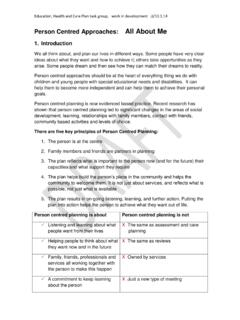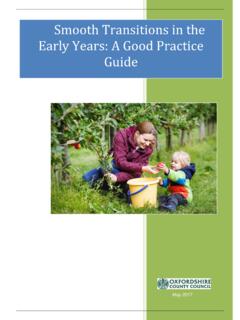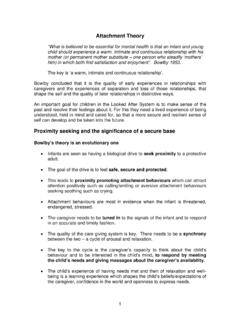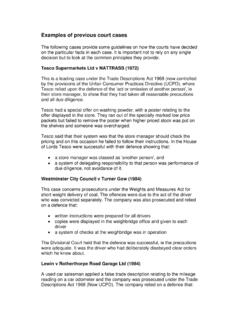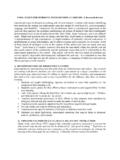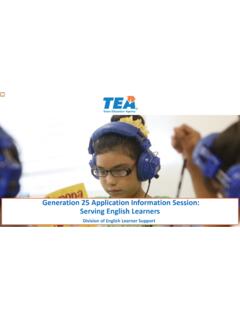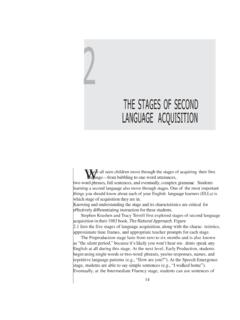Transcription of Guidance for Early Years practitioners on supporting ...
1 August 2017 Guidance for Early Years practitioners on supporting children learning english as an Additional language (EAL). 1 Contents Introduction .. 2 How do we know if a child is EAL? .. 2 Definitions of EAL .. 2 Principles and Best Practice .. 3 practitioners and Learning .. 4 Statutory requirements in the Early Years .. 7 The Characteristics of Effective Learning .. 9 UN convention on the Rights of the Child .. 10 Assessment of education provision .. 11 Strategies for supporting /developing communication in english .. 13 Appendix 1 Observations of EAL and suggested practitioner Strategies .. 14 School EAL proficiency requirements new codes .. 17 How to identify and support EAL learners with Special Educational Needs .. 18 Appendix 2 Case studies.
2 20 Ofsted inspection quotes and improvement needed quotes .. 20 Frequently asked questions .. 21 Books for EAL Learner .. 22 Games for Early Years EAL learners .. 23 Useful links/references .. 24 2 Introduction We can do a lot to support children who are learning EAL in our Early Years settings. These days there are many instances of bilingualism and multilingualism within our settings, and it is our job to support these children in communicating effectively with adults and peers, and to ensure they are progressing well within all areas of learning. At present, data shows that children with EAL under perform in the EYFSP compared with children whose first language is english . We therefore need to follow the specific Guidance in the EYFS: for children whose home language is not english , providers must take reasonable steps to provide opportunities for children to develop and use their home language in play and learning, supporting their language development at home.
3 Providers must also ensure that children have sufficient opportunities to learn and reach a good standard in english language during the EYFS, ensuring children are ready to benefit from the opportunities available to them when they begin year 1. When assessing communication, language and literacy skills, practitioners must assess children s skills in english . If a child does not have a strong grasp of english language , practitioners must explore the child s skills in the home language with parents and/or carers, to establish whether there is cause for concern about language delay. How do we know if a child is EAL? Below are official definitions of EAL by the DFE and OFSTED, accompanied by Guidance as to interpret them. If you consider a child to be EAL, then you must record their home language code on the school census (see appendix 2) EAL - The Department of Education definition A pupil s first language is defined as any language other than english that a child was exposed to during Early development and continues to be exposed to in the home or community.
4 If a child was exposed to more than one language (which may include english ) during Early development, a language other than english should be recorded, irrespective of the child s proficiency in english . EAL - The Ofsted definition english as an additional language (EAL) refers to learners whose first language is not english . These definitions therefore cover the following: Pupils arriving from other countries and whose first language is not english Pupils who have lived in the UK for a long time and may appear to be fluent, but who also speak another language at home. These pupils are often not entirely fluent in terms of their literacy levels. Pupils who have been born in the UK, but for whom the home language is not english ( Bengali children who are born in the UK, but arrive at school with very little english due to having spoken only Bengali at home and within the community) Pupils who have a parent who speaks a language other than english and the child communicates with in that language (ie.)
5 Bi-lingual children) It is important therefore to recognise that: Children who have British citizenship can still be EAL. If parents write on their child s admission form that the child speaks english as a first language , when it is clear that one or both of these parents is a speaker of another language , the child is very likely in fact to be EAL, and it will be necessary to check this. 3 Principles and Best Practice The following best practice principles and guidelines will support all children's developing speech, language and communication skills. The strategies you should provide for all children will also support children learning EAL: All children are entitled to equal access to the whole curriculum. Learning and using more than one language is an asset, and is a learning opportunity for both children and adults in the setting.
6 Good development of a child's first language has a positive effect on the development of other languages. An atmosphere where being able to speak other languages should be truly valued as a positive skill. The use of stories, books, rhymes and songs are a vital part of worldwide cultural and linguistic heritage. 4 practitioners and Learning Things to consider: Practice and provision: Do we? Ensure we have structures and practice that promotes general best practice in supporting and developing young children's speech, language and communication? Ask on our application form for home languages and religious cultural information, and find out what sort of learning experiences the child has at home?
7 Ensure correct spelling and pronunciation of children's and parents' names? Offer a home visit where parents may feel more relaxed and able to talk about their child's strength and interests, as well as a full range of language skills and experiences? If possible, assess a child in their first language , and involve the parents in the assessment process? Do we value children's first language in print, and children's Early attempts in mark making in different scripts? Recognise that children new to english may need additional adaptations to the learning environment (PECS, visual timetable, signing)? Support staff to find resources, and to find interpreters to support children and families with EAL? (eg; google translate for newsletters/information, link with language schools, or other families with the same language ).
8 Provide lots of experiences and activities that promote language through play, embedding language in the actual and concrete? Ensure children learn language in social situations by interacting with adults and other children? Offer differentiated and challenging play activities to support language development (storytelling with props)? Provide positive imagery ensuring children's home languages and experiences are reflected in the settings resources in order to develop a child's well-being and positive self-image? The child: Children with EAL might have to learn: A new set of sounds and sound groupings New intonation patterns A new script or alphabet A new set of sound symbol relationships New vocabulary New grammar New non-verbal signals New rules about social conventions and language Ability to relate to people and express feelings and emotions in a new language Do we?
9 Allow children new to english some period of time when they may just listen before they respond, whilst all the time talking to them, observing and monitoring their progress? Understanding is almost always in advance of spoken language ; it is important that children should not feel pressurised to speak until they feel confident to do so. It is essential that adults continue to talk to the children, respond to their non-verbal responses and involve them in all aspect of the Early Years setting. Plan for children to be included in smaller groups which include children who are fluent english speakers? 5 Plan for times when the child can be involved which require little or no english giving out snacks or drinks at snack time? Listen to a child's attempts at communication, and encourage and attempt to interpret what they said?
10 Ensure children know survival language ? toilet, hello, goodbye, yes, no, drink, unwell. Ensure ALL children have access to all adults (teacher, bilingual workers etc) Constantly model language in a variety of situations (formal and informal) and give a running commentary during activities, to support children s understanding and access to appropriate vocabulary. Praise ANY attempt by the child to join in conversations (non-verbal, verbal - and give correct words). Explain social contexts to children in their own language (through interpreters) so that they feel comfortable with routines and cultural differences when they start at the setting. The Family: Do we? Ensure the family still use the home language regularly so that they support their child s learning, well-being and self- image, as well as their developing communication skills in both languages.

